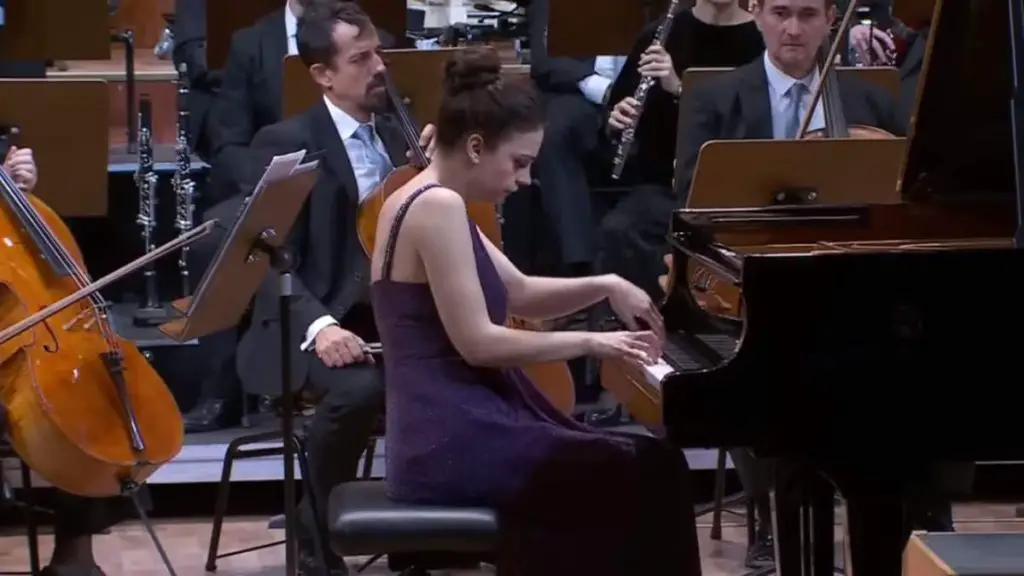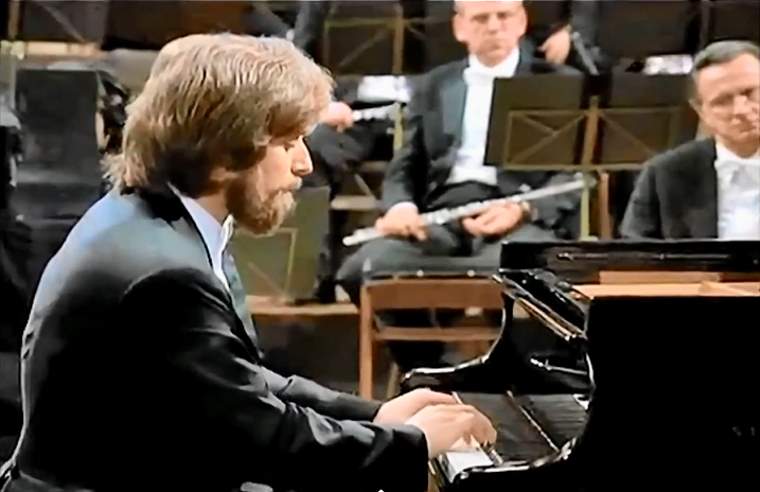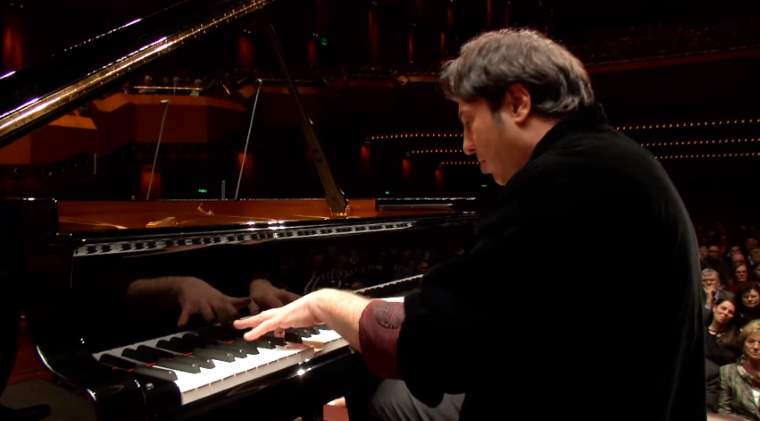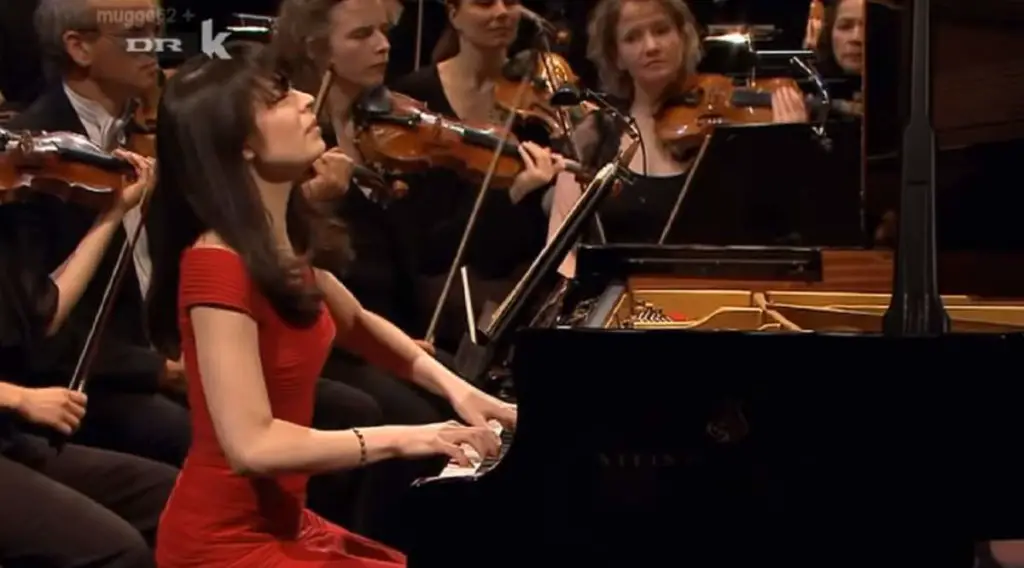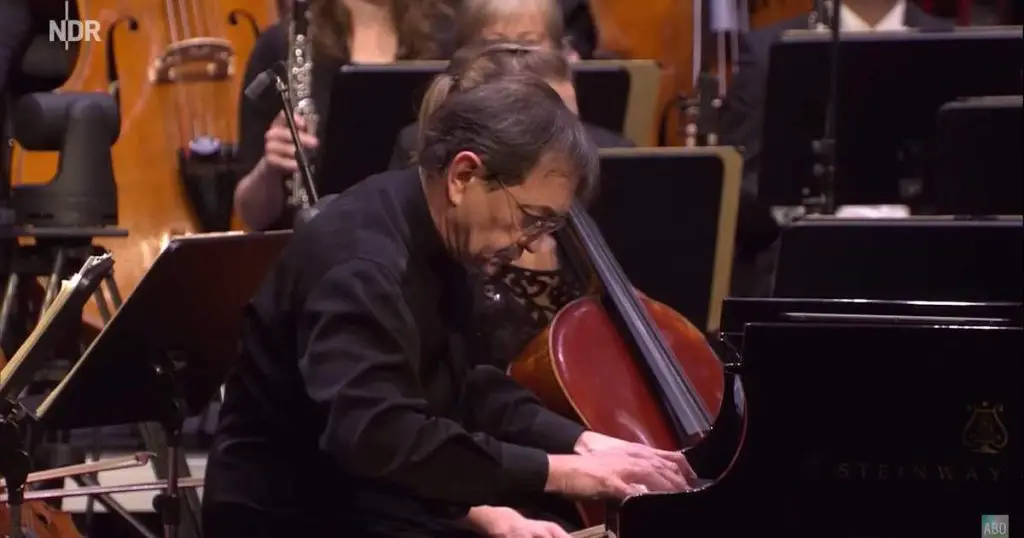Accompanied by the Filharmonie Bohuslava Martinů (Bohuslav Martinů Philharmonic Orchestra), the German pianist Olga Scheps performs Ludwig van Beethoven’s Piano Concerto No. 3 in C minor, Op. 37. Conductor: Robert Kružík. This performance was recorded in 2021.
Ludwig van Beethoven’s Piano Concerto No. 3
Beethoven’s Piano Concerto No. 3 in C minor, Op. 37, is a significant work in the classical repertoire, reflecting a pivotal period in Ludwig van Beethoven’s musical career. Composed during the early 1800s, this concerto marked a transition from the Classical style, heavily influenced by Mozart and Haydn, to a more personal and expressive style that would eventually define the Romantic era.
The concerto is known for its dramatic and emotional depth. Its key of C minor is noteworthy as Beethoven often reserved this key for works of particular intensity and passion. The choice of key itself reflects the influence of Mozart, particularly his Piano Concerto No. 20 in D minor, which Beethoven greatly admired.
One of the remarkable aspects of this concerto is how it showcases the piano both as a solo instrument and as an integral part of the orchestral texture. Beethoven’s innovative approach is evident in the way he blends the solo piano with the orchestra, creating a dialogue rather than a mere accompaniment. This was a departure from the more ornamental role of the piano in many earlier concertos, where the orchestra often dominated.
The concerto also reflects Beethoven’s growth as a composer and pianist. It is technically demanding, requiring a high degree of virtuosity from the soloist. This complexity is not just for show; it serves to deepen the emotional expression of the music. Beethoven himself was known for his impressive skills at the piano, and this concerto is a testament to his abilities as both a performer and a composer.
Moreover, Beethoven’s Piano Concerto No. 3 is significant for its structural innovation. While it adheres to the traditional three-movement concerto form, Beethoven expands and develops these structures to allow for greater expressive depth and complexity. This is particularly evident in the development sections, where he explores a wide range of themes and harmonies, adding to the dramatic narrative of the concerto.
In terms of its reception and legacy, Beethoven’s Third Piano Concerto has been highly influential. It paved the way for the more emotive and technically challenging piano concertos of the Romantic era. Its blend of Classical form with new, more personal levels of expression marked a turning point in the evolution of the concerto form.
Movements
With start times in the video:
- [00:36] Allegro con brio
- [18:56] Largo
- [30:27] Rondo: Allegro – Presto
1. Allegro con brio
The first movement of Beethoven’s Piano Concerto No. 3 in C minor, Op. 37, is an expansive and dramatic Allegro con brio. This movement beautifully encapsulates Beethoven’s evolving musical style and his prowess in blending traditional concerto elements with his own innovative ideas.
Structurally, the movement adheres to the classical sonata form, a staple in concerto movements of the time, consisting of an exposition, development, and recapitulation. However, Beethoven infuses this structure with a depth and complexity that was quite advanced for his time.
The exposition begins with the orchestra introducing the main themes. This orchestral introduction is notable for its length and the dramatic development of the themes. It sets the stage for the piano’s entrance, which then takes up these themes and expands upon them. Beethoven’s use of the piano here is not just as a solo instrument but as an integral part of the overall musical texture, dialoguing with and sometimes challenging the orchestra.
The development section is where Beethoven truly shows his compositional mastery. He takes the main themes and subjects them to extensive development, exploring a wide range of keys, dynamics, and textures. This section is characterized by its dramatic shifts and the intense interplay between the piano and the orchestra.
In the recapitulation, the main themes return, but now altered and enriched by the journey they have undergone in the development. This section reaffirms the key of C minor, bringing back the initial themes with a sense of heightened drama and resolution.
Throughout the movement, Beethoven’s use of harmony is particularly striking. He often uses unexpected harmonic turns that add to the dramatic tension of the piece. The piano part is both technically challenging and expressively rich, requiring the soloist to possess not just virtuosity but also a deep sense of musicality to bring out the nuances of the score.
The movement concludes with a coda that brings the dramatic and emotional journey to a powerful close. This coda further develops the main themes and ends the movement with a sense of decisive resolution, showcasing Beethoven’s ability to blend drama, technical skill, and expressive depth in a cohesive and compelling manner.
2. Largo
The second movement of Beethoven’s Piano Concerto No. 3 in C minor, Op. 37, is a poignant and lyrical Largo, providing a striking contrast to the dramatic and turbulent first movement. This movement is a showcase of Beethoven’s ability to craft deeply expressive and introspective music, and it’s often cited as one of his most beautiful slow movements.
In this movement, the key shifts from the stormy C minor to the serene and luminous E major, a typical Beethovenian move to create contrast and emotional depth. This key change brings a sense of calm and introspection, a common trait in Beethoven’s slow movements where he often explores a more reflective and tender side of his musical persona.
The Largo opens with a gentle orchestral introduction, setting a tranquil and contemplative mood. The orchestration here is subtle, with Beethoven using the instruments to create a soft, cushioned backdrop for the piano’s entrance. This is in line with the classical concerto tradition, where the orchestra often provides a supportive role in the slow movements.
When the piano enters, it takes up a singing melody that is both simple and profoundly expressive. This melody, played in the piano’s upper register, has a vocal quality, almost like an operatic aria. Beethoven’s use of the piano here is not about virtuosity or technical display; instead, it’s about deep musical expression and the ability to convey emotion through melody.
The interaction between the piano and the orchestra is one of partnership and dialogue. Unlike the first movement, where the relationship can be more confrontational, here the piano and orchestra seem to converse and support each other, creating a peaceful and introspective atmosphere.
Throughout the movement, Beethoven explores various shades of emotion, from tender warmth to deeper, more introspective moments. His use of harmony is subtle yet effective, with gentle modulations that enhance the reflective character of the movement.
The Largo is not only a showcase of Beethoven’s melodic gifts but also of his ability to create a profound emotional narrative within a relatively simple structure. The movement doesn’t have the dramatic development or thematic complexity of the outer movements, but its beauty lies in its simplicity and emotional directness.
As the movement draws to a close, the music gradually fades, ending quietly and leaving the listener in a state of contemplative calm. This sets the stage for the transition to the final movement, providing a moment of introspection before the concerto moves to its energetic and spirited conclusion.
3. Rondo: Allegro – Presto
The finale of Beethoven’s Piano Concerto No. 3 in C minor, Op. 37, is a lively and spirited Rondo. Marked Allegro-Presto, this movement brings the concerto to an energetic and triumphant conclusion. This movement is characterized by its rhythmic vitality, melodic inventiveness, and the playful interplay between the piano and the orchestra.
In classical concertos, the final movement often takes the form of a rondo, a musical structure that features a recurring main theme (the refrain) alternating with contrasting episodes. Beethoven follows this tradition but infuses it with his unique flair and creativity.
The movement opens with the orchestra introducing the main rondo theme, a catchy and rhythmic melody that sets the tone for the rest of the movement. This theme has a lively and buoyant character, contrasting sharply with the introspective mood of the second movement. It’s in a bright C major, marking a shift from the darker C minor of the first movement and the contemplative E major of the second.
When the piano enters, it takes up the rondo theme and adds its own virtuosic flourishes. The solo part is both playful and technically demanding, showcasing the pianist’s skills in rapid runs, trills, and lively figurations. Beethoven’s writing for the piano here is full of energy and brilliance, a reflection of his own abilities as a pianist.
Throughout the movement, Beethoven introduces various contrasting episodes that provide a counterpoint to the main theme. These episodes explore different moods and textures, from lyrical and flowing to more dramatic and intense. The interplay between the piano and orchestra is particularly engaging, with the piano often leading the way and the orchestra responding or complementing the soloist’s lines.
One of the striking features of this movement is Beethoven’s use of rhythm and syncopation, which adds to the sense of energy and forward momentum. The rhythmic drive of the movement is relentless, pushing the music forward and creating a sense of excitement and joy.
As the movement progresses, the rondo theme returns several times, each time varied and developed in different ways. This keeps the movement fresh and engaging, as Beethoven finds new ways to explore and embellish the theme.
The movement culminates in a spirited and virtuosic coda, where Beethoven brings back the main theme in a final, triumphant statement. This coda is a showcase of pianistic brilliance and orchestral power, leading to a thrilling and satisfying conclusion to the concerto.
Sources
- Piano Concerto No. 3 (Beethoven) on Wikipedia
- “Exploring Beethoven’s Piano Concerto No. 3: A Masterpiece of Passion and Innovation” on the LV Beethoven website
- “Piano Concerto No. 3, Ludwig van Beethoven” on the LA Phil website
